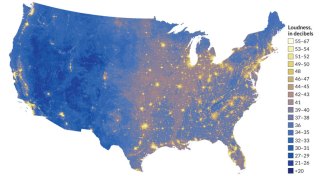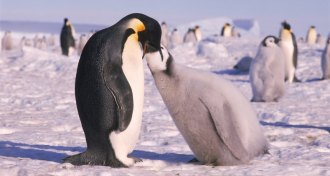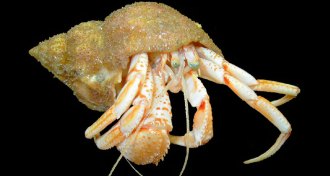Life
Sign up for our newsletter
We summarize the week's scientific breakthroughs every Thursday.
-
 Environment
EnvironmentA coast-to-coast picture of America’s cacophony of sounds
The National Park Service mapped noise across the United States.
By Susan Milius -
 Genetics
GeneticsFor penguins, it’s a matter of no taste
Penguins lack taste genes for bitter, sweet and umami.
-
 Genetics
GeneticsEbola virus evolution tracked by genetic data
Analysis of Ebola genomes shows how the virus has evolved and some of the mutations that may thwart treatments.
-
 Life
LifeTo deal with sexual conflict, female bedbugs get flexible
Female bed bugs evolved an elastic underbelly to tolerate violent mating, a new study suggests.
-
 Neuroscience
NeuroscienceChronic pain treatments may get boost from high-tech imaging
Advanced imaging may reveal how well chronic pain treatments work.
-
 Animals
AnimalsFertile hermit crabs turn shy
Male hermit crabs that aren’t carrying much sperm are bolder than their more fertile brethren, a new study finds.
-
 Paleontology
PaleontologyEarliest tree-dweller, burrower join mammal tree of life
Fossils show mammal ancestors did a lot more than cower in dinosaurs’ shadows.
By Susan Milius -
 Animals
AnimalsTiger swallowtail genome gives clues to insect’s stinky defense
Clues within the genetic code of the Eastern tiger swallowtail butterfly (Papilio glaucus) explain how it developed a smelly defense against predators.
-
 Animals
AnimalsWhen you’re happy and you show it, dogs know it
A new test using pictures of halves of human faces challenges dogs’ abilities to read people’s emotions.
By Susan Milius -
 Genetics
GeneticsAncient East Asians mixed and mingled multiple times with Neandertals
East Asians’ ancestors interbred with Neandertals more than once, explaining why modern East Asians carry more Neandertal DNA than Europeans do, two studies suggest.
-
 Animals
AnimalsWasps may turn ladybugs into zombies with viral weapons
Parasitic wasps may use a neurological virus to make ladybugs their minions, a study posits.
-
 Health & Medicine
Health & MedicineU.S. measles tally for 2015 now at 121 cases
The 2014–2015 measles outbreak in the United States has now reached people in 17 states and the District of Columbia.
By Nathan Seppa